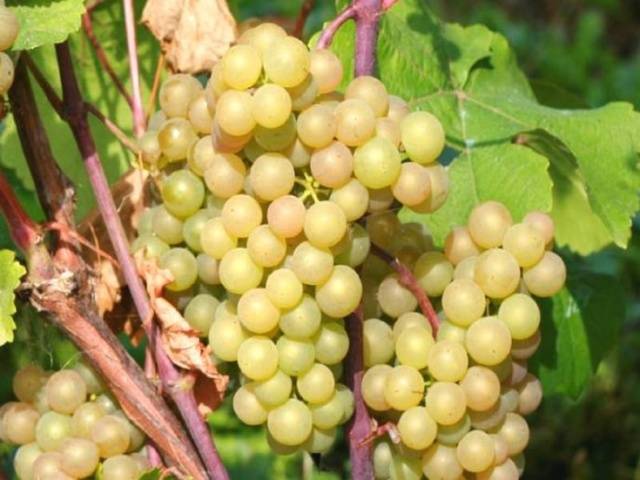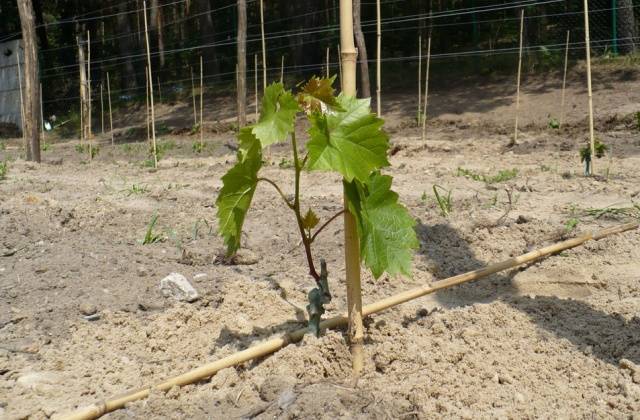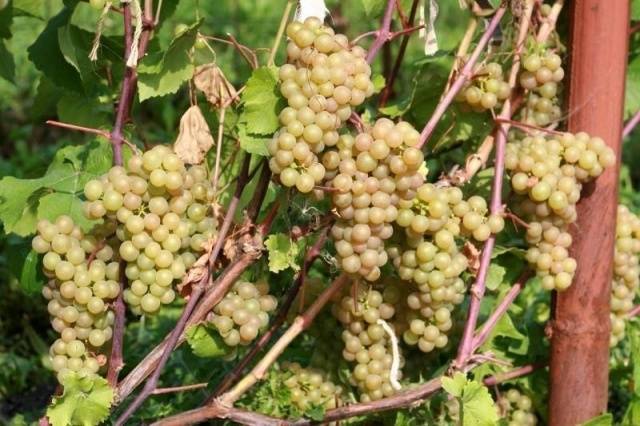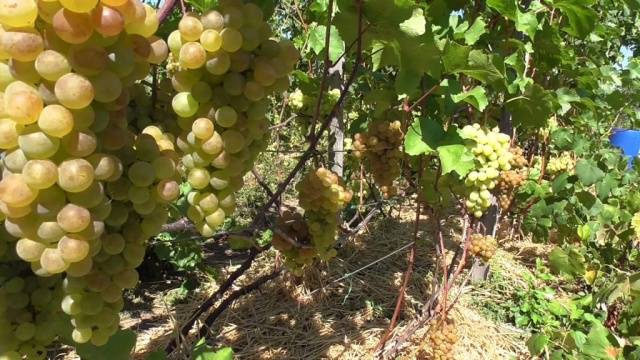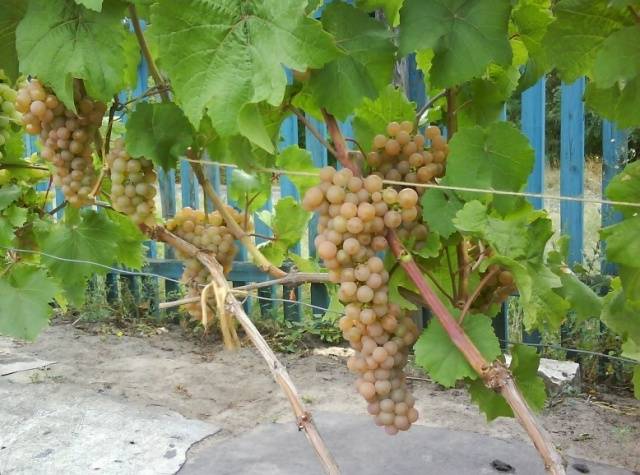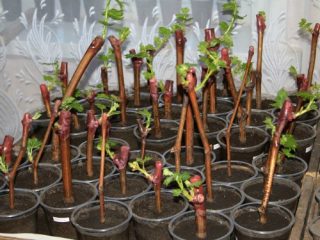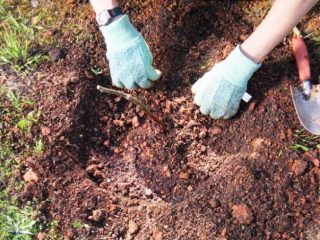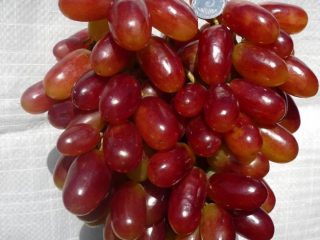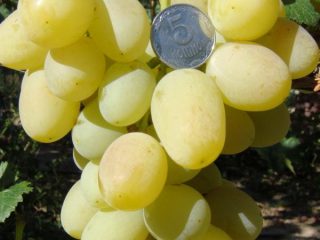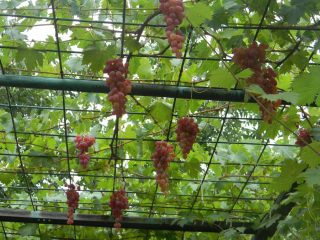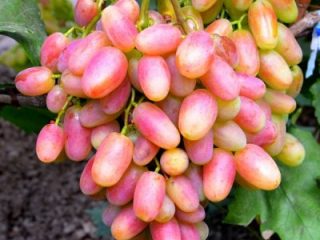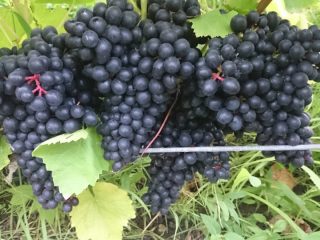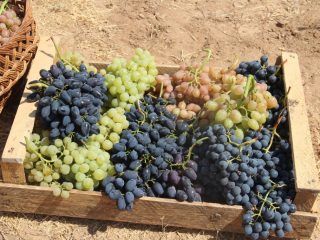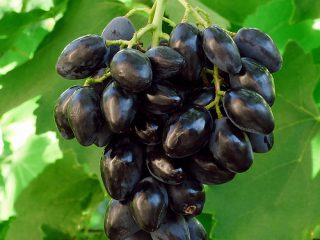Content
Platovsky grapes are a technical variety of crop that yields crops early. The variety was obtained by Russian breeders by crossing the Podarok Magaracha and Zaladende grapes. Alternative name: Early Dawn. The variety is valued for its good taste, resistance to frost, diseases and pests.
Characteristics of the variety
Description and photo of Platovsky grape variety:
- technical grade;
- ultra-early ripening in 110 days;
- medium-sized bushes;
- cylindrical-conical brushes;
- clusters of medium density;
- average hand weight 0.2 kg;
- ripening of shoots up to 80%;
- An average of 1-3 clusters are formed on each branch.
Description of Platovsky variety berries:
- weight 2 g;
- round shape;
- white color, a pinkish tint appears in the sun;
- sugar content about 20%;
- acidity 8.9 g/l;
- juicy pulp;
- thin skin.
After ripening, the berries can remain on the bushes for a month. The Platovsky variety is used to produce dessert and table wine. The taste qualities of dry table wine are rated at 8.4 points.
The Platovsky grape variety can withstand winter frosts down to -29 °C. In regions with colder winters, bushes need shelter.
Planting grapes
Platovsky grapes are planted on a prepared site.The place for growing the crop is chosen taking into account light, humidity and soil structure. When planting, mineral fertilizers must be applied.
Preparatory stage
For grapes, choose a lighted area located on the south, west or southwest side. Plants are not planted near fences or buildings. The permissible distance to fruit trees is 5 m.
The vineyard is not planted in lowlands where moisture accumulates. When planting on a slope, its central part is allocated for the crop.
Annual seedlings with a height of 0.5 m are suitable for planting. The thickness of the shoot is 6 cm, the length of the roots is 10 cm. The root system should not be overdried, and the plant should have healthy buds.
Planting work is carried out in October. It is allowed to plant the crop 10 days before the cold snap. Autumn planting is considered more preferable than spring planting. This gives the plants time to take root before winter sets in.
Work order
A planting hole is being prepared for Platovsky grapes. It is dug up 2-3 weeks before planting.
Sequence of work:
- In the selected area, dig a hole 80 cm in size and 60 cm in depth.
- A drainage layer of expanded clay or pebbles 10 cm thick is placed at the bottom.
- A plastic pipe with a diameter of 6 cm is dug in vertically. Up to 15 cm of the length of the pipe is left above the surface.
- A bucket of compost, a glass of Nitrophoska and wood ash are added to the fertile soil.
- The hole is filled with soil mixture and left for the soil to shrink.
Before planting, the Platovsky grape seedling is trimmed, leaving 4 eyes. The roots of the plant are shortened slightly and placed in a mash consisting of 10 liters of water, 1 tsp. sodium humate and clay.
A mound of fertile soil is poured into the hole, where the seedling is placed. Its roots are covered with soil and watered abundantly. At first, the soil under the plant is covered with plastic film. It is removed when the plant takes root.
Variety care
The yield of Platovsky grapes depends on the care of the plantings. Plants are watered and fed throughout the season. To prevent diseases, plantings are sprayed with special means. In the fall, pruning is done to ensure optimal load on the plant.
Watering
For a month after planting, Platovsky grapes are watered every week with 5 liters of warm water. Then moisture is added twice a month.
Mature grapes are watered several times during the season:
- in the spring after removing the cover;
- a week before the buds open;
- after flowering.
Consumption per bush – 4 liters of warm, settled water. Before watering, you can add 0.5 kg of wood ash to the water. It is better to water the grapes rarely, but use large volumes of water. Moisture should not be on the leaves and stems of plants.
Moisture is introduced using a pipe dug in when planting. In the absence of an irrigation system, prepare special holes. The plants retreat 30 cm from the trunk and make furrows to a depth of 25 cm. After watering, they are covered with earth.
When the berries begin to ripen, watering the plants is completely stopped. In the fall, before covering the grapes, a final watering is performed to help the plants survive the winter.
Top dressing
If fertilizers were used when planting grapes, then regular fertilizing begins only in the 3rd year. By this time, the bushes will grow and begin to bear fruit. Mineral and organic substances are used for processing.
Feeding scheme for Platovsky grapes:
- in early spring;
- during the formation of buds;
- when the first berries ripen.
In the spring, after the snow melts, Platovsky grapes are watered with slurry, to which 30 g of superphosphate and potassium salt are added. Instead of organics, use urea or ammonium nitrate.
For subsequent treatments, only potassium and phosphorus fertilizers are used. Substances are added dry to the soil or dissolved in water.
Platovsky grapes respond positively to foliar treatments. Plants are sprayed leaf by leaf with complex preparations Novofert, Kemira or Aquarin. For processing, choose a cloudy day or postpone the procedure until the evening.
Tying and trimming
The vine is tied to a support to facilitate care. To do this, install supports, between which the wire is pulled.
The branches are tied vertically, horizontally or in an arc. The shoots are attached to the trellis at an angle so that they are evenly illuminated by the sun and do not break under the weight of the harvest.
In autumn, grapes are pruned to eliminate excess shoots. From 6 to 80 eyes are left per bush. The branches are pruned into 4 eyes.
In spring, only dry and frozen branches are removed. In summer, weak and infertile stepsons are removed. To improve the taste, the leaves covering the bunches of berries are torn off.
Shelter for the winter
Platovsky grapes are grown in regions with cold or little snowy winters. Plants are pruned and removed from the vines. The culture tolerates temperatures down to +7 °C.
The bushes are covered with earth, metal arcs are installed on top and agrofibre is stretched.To prevent the grapes from rotting, leave the entrance and exit open. They are closed when the temperature drops to -15 °C. Additionally, snow is thrown over the bushes in winter.
Protection from diseases and pests
The Platovsky variety is resistant to oidium, mildew and gray rot. The diseases are fungal in nature and develop with insufficient care, high humidity, and dense plantings.
A white coating appears on the surface of the leaves and stems, which gradually grows, leading to loss of yield and death of the plant.
To combat diseases, the drugs Horus, Antrakol, Ridomil are used. The concentration of substances must correspond to the instructions. For preventive purposes, plantings are treated in the spring before buds open and in the fall after harvesting.
The Platovsky variety is resistant to the most dangerous grape pest – phylloxera. The insect enters the plantings with planting material and is carried by water and wind. The spread of the pest can be avoided by growing resistant varieties.
Damage to vineyards is caused by mites, leaf rollers, cicadas, and cushion borers. For pests, the drugs Actellik, Karbofos, Fufanon are used. If insects are detected, the bushes are sprayed at intervals of 10 days.
Reviews from gardeners
Conclusion
The Platovsky grape variety is grown for winemaking and fresh consumption. The variety is characterized by high winter hardiness and unpretentiousness. Despite the small size of the berries, Platovsky grapes are distinguished by early ripening and abundant fruiting.
The grapes are planted in prepared areas, watering and fertilizing are provided. If the rules of planting and care are followed, the variety is little susceptible to diseases. For winter, plants are pruned and covered if necessary.
